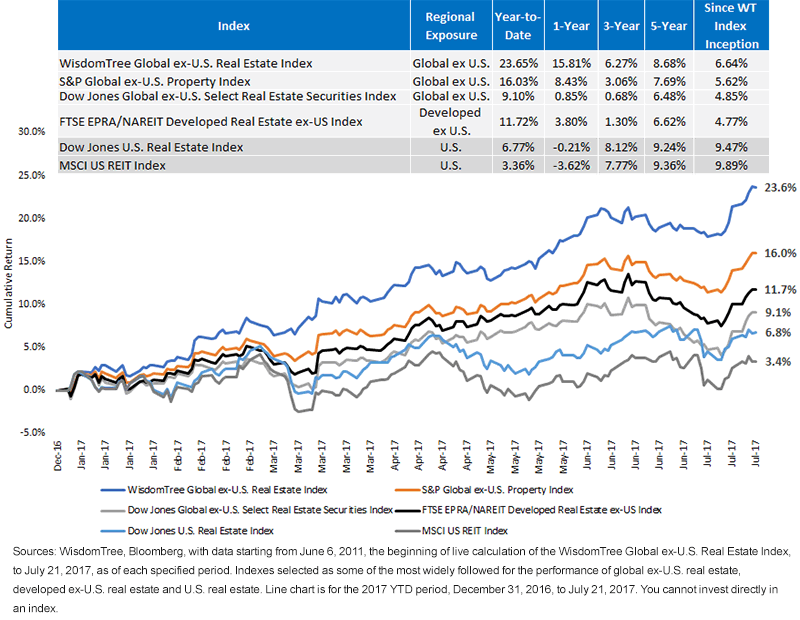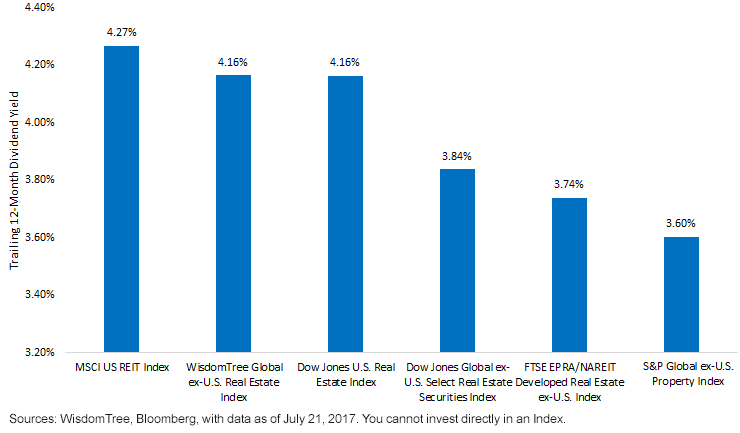Global ex U.S. Real Estate Has Caught Fire in 2017


Searching for Opportunities Outside the U.S.
At WisdomTree, we have been writing about opportunities in markets outside the U.S. for some time, noting that thus far in 2017:
- Emerging market equities—particularly those less sensitive to commodity price movements—have done well
- Developed international markets, buoyed by positive election results in places such as France, have done well
- With a weakening U.S. dollar, exposure to global currencies has been beneficial
Investors often look at real estate as an inflation hedge. Given where inflation-adjusted bond yields are around the world, this asset class has particularly interesting characteristics. But by looking at just U.S. real estate, you could be missing out on large swaths of the world’s real estate opportunities. The data actually suggests that of the $2.1 trillion market capitalization of global real estate, more than 61% (approx. $1.3 trillion) is located outside the U.S.1
The WisdomTree Global ex-U.S. Real Estate Index has done well in 2017 by touching upon each of these developments. It is also unique in the marketplace in that its focus extends beyond the developed world with Europe and Japan and also includes emerging market real estate.
WisdomTree Global ex-U.S. Real Estate Index Has Dramatically Outperformed Other ex-U.S. Real Estate Indexes

- 2017 Outperformance Stands Out: Each of the global or developed ex-U.S. indexes focuses on real estate outside the U.S., but country exposures tend to be quite different. While all the indexes included exposure to Hong Kong, only the WisdomTree and S&P indexes had exposure directly to China, and WisdomTree had approximately twice the weight. For WisdomTree’s approach, the China real estate stocks were up more than 100% over the period. On the opposite end of the spectrum was Japan, one of the worst-performing real estate markets in 2017. Japanese real estate represented more than 20% weight in each of the three non-WisdomTree indexes shown here that were focused on real estate outside the U.S., but it was a less than 10% exposure in the WisdomTree Index.
- Other Notable Differences in Exposure: While Japan and China represented the biggest contrast, there was also a broader theme contributing to WisdomTree’s outperformance. The WisdomTree Global ex-U.S. Real Estate Index is weighted by cash dividends paid by constituents as opposed to their market capitalization. This creates an opportunity for emerging market real estate firms that pay large dividends to gain greater representation, and that has been the main driver of a relative over-weight in emerging market real estate and an under-weight in major developed markets such as Japan. In fact, as of July 21, 2017, 18.1% of the total exposure of the WisdomTree Index was to real estate firms within emerging markets.2
- Persistence of Outperformance: Instead of focusing only on one period of about seven months, we also looked back in time. The persistence of WisdomTree’s outperformance extends beyond 2017, and it was particularly evident on the three-year horizon. It was again the under-weight to Japan that was the most important factor, as Japan’s real estate has been challenged over that period as well. It’s also worthwhile to see the contrast with the two widely followed U.S. real estate indexes, beginning to lag the non-U.S. indexes over the one-year horizon but still looking strong for the periods beyond one year. Maybe this portends a shift to non-U.S. real estate outperformance.
Potential to Continue the Outperformance?
This is the real question, because we all know that past outperformance cannot be a predictor of future performance. What it can tell us is that the methodology employed by the index worked in making a real difference in returns over time. If the same methodology is employed going forward, then it may be possible to generate future outperformance.
WisdomTree’s methodology can be summed up in two words: relative value.
The China Example
We saw above that a main driver of WisdomTree’s relative outperformance over the other three indexes is that WisdomTree’s exposure to China’s real estate firms was up more than 100%. This could be worrisome—how much higher can one market go after it doubles in less than one-year? In a market capitalization-weighted approach, a market that outperforms all others to such a degree would therefore be increasing its market cap size and also its representation within the index.
WisdomTree’s approach is completely different, in that a market that outperforms all others to such a degree is also very likely to outperform the growth of its own fundamentals, in this case dividends. Any market where share price functions to outperform dividend growth—especially to a large degree—is one where WisdomTree would be trimming weight at the Index’s upcoming rebalance in October.
Why Is Real Estate an Attractive Asset Class?
In conclusion, it is helpful to think about why real estate has become the asset class it is today. A big reason for its recognition is income, particularly in the low-yield environment that continues to pervade developed markets. We see in the data below that the U.S. real estate-focused indexes have very attractive yields, but with WisdomTree’s methodology, one can look to non-U.S. real estate with a similar dividend yield level, thereby mitigating what many may have viewed as a negative trade-off to focusing abroad.
Global ex-U.S. Real Estate Indexes Offer Attractive Dividend Yields

In today’s interest rate environment, the relatively higher yields of all these indexes are worth consideration, but it is notable to look at WisdomTree due, again, to its methodology. If the constituents are weighted by the income they generate, that functions to create an opportunity to deliver a higher dividend yield—in some cases the main purpose for looking to real estate in the first place.
1Source: Bloomberg, with data as of 7/21/17. Refers to FTSE EPRA/NAREIT Global ex US Index and FTSE EPRA/NAREIT United States Index.
2Sources: WisdomTree, Bloomberg.
Christopher Gannatti began at WisdomTree as a Research Analyst in December 2010, working directly with Jeremy Schwartz, CFA®, Director of Research. In January of 2014, he was promoted to Associate Director of Research where he was responsible to lead different groups of analysts and strategists within the broader Research team at WisdomTree. In February of 2018, Christopher was promoted to Head of Research, Europe, where he was based out of WisdomTree’s London office and was responsible for the full WisdomTree research effort within the European market, as well as supporting the UCITs platform globally. In November 2021, Christopher was promoted to Global Head of Research, now responsible for numerous communications on investment strategy globally, particularly in the thematic equity space. Christopher came to WisdomTree from Lord Abbett, where he worked for four and a half years as a Regional Consultant. He received his MBA in Quantitative Finance, Accounting, and Economics from NYU’s Stern School of Business in 2010, and he received his bachelor’s degree from Colgate University in Economics in 2006. Christopher is a holder of the Chartered Financial Analyst Designation.

